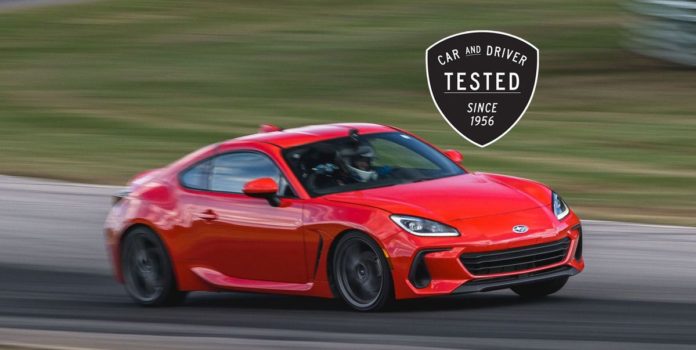- For around $2100, we significantly improved our Subaru BRZ’s track performance by upgrading its brakes and tires.
- Improved skidpad and braking test results translated into a 3.1-second quicker lap time around Virginia International Raceway’s Grand Course.
- Trade-offs for the improvements include a slightly stiffer ride and excessive brake noise around town.
Welcome to Car and Driver’s Testing Hub, where we zoom in on the test numbers. We’ve been pushing vehicles to their limits since 1956 to provide objective data to bolster our subjective impressions (you can see how we test here).
We love the Subaru BRZ (and its Toyota GR86 twin). Our long-term 2023 Limited model has provided us with the opportunity to soak in the pluses and minuses of Subie’s sports coupe for nearly 40,000 miles. But it’s also given us a chance to see if a few aftermarket upgrades can make it even better, and indeed they do.
While we haven’t touched our BRZ’s suspension, engine, or drivetrain, some simple brake-and-tire upgrades have noticeably enhanced its capability when pushed to its limit—both around Virginia International Raceway and when subjected to our usual battery of handling and braking tests. We embarked on this undertaking to see if budget-minded upgrades could address the BRZ’s (and the GR86’s) primary shortcoming: weak brakes that don’t stand up well to heavy abuse, which result in longer braking distances on the track and, ultimately, slower lap times.
To recap, last fall we outfitted our BRZ with a set of track-oriented Carbotech XP12 brake pads ($437) and new OE brake rotors ($364). We went this route versus a more comprehensive big-brake package because, well, time and money; installing a big-brake kit requires significantly more of both, and that simply didn’t jibe with the BRZ’s minimalist mission. To ensure we got the most out of the upgraded stoppers, we also replaced the stock brake fluid with high-temperature Castrol React SRF Racing DOT4 fluid ($56 via Amazon).
To capitalize on these changes, we then replaced our Limited model’s stock 18-inch Michelin Pilot Sport 4 summer tires (sized 215/40R-18) with a set of slightly wider 225/40R-18 Bridgestone Potenza Race tires, which feature a stickier, track-oriented compound yet remain street legal ($1220 on Tire Rack). While Bridgestone does not consider this to be its ultimate performance tire in terms of lap time, the Potenza Race shines in other areas, offering impressive amounts of grip without altering the general balance of the car that they’re installed on. From our experience, they’re also quite durable, returning consistent lap times over a track session.
With the rotors bedded in (we paid Carbotech $40 to prep the pads for us), the benefits of these modifications quickly became apparent at the test track, where the BRZ orbited the skidpad with 1.01 g of grip, up from its initial effort of 0.95 g when new. And in our stopping tests from 70 and 100 mph, our Subaru came to halt in 143 and 285 feet, respectively, down significantly from its baseline measurements of 162 and 318 feet.
Later at our Lightning Lap event at VIR—the full coverage of which you can read about soon—these improvements were good for a 3.1-second reduction around the daunting 4.1-mile Grand Course, with the BRZ now posting a time of 3:09.3—quick enough to beat a 2006 Porsche Cayman S and nipping at the heels of a 2021 Toyota Supra 2.0. Drivers reported that the car’s playful composure remained fully intact despite its noticeably enhanced stick, which combined with the stronger initial bite from the brakes and their increased stopping power, resulted in quicker times in all of the track’s five sectors.
Unsurprisingly, the Potenzas’ stiff sidewalls reduced the car’s ride comfort on the street, and like all summer tires, their grip was greatly diminished in colder temperatures. Similarly, the upgraded brakes often needed to be warmed up on cold mornings before they started working properly. Our car’s logbook also quickly filled with complaints about the ear-piercing squeal that the brakes emitted around town. This is not a setup we’d recommend driving on day after day, and we soon reinstalled the stock brakes and our car’s 16-inch winter wheels and tires for Michigan’s dreariest months. But the benefits of the setup are real.
With the introduction of the 2024 BRZ tS model and its upgraded suspension and Brembo brakes, Subaru will now handle most of this upgrade work for a modest upcharge of $2650 over a BRZ Limited with a manual transmission. That’s slightly more than what we ended up spending on our car, though the tS also comes with the additional refinement of a factory setup. We’ve driven that model but haven’t yet tested one, so we can’t say if its improvements will be as pronounced. For existing BRZ owners, the aftermarket route may be the only option. Still, the lesson from our little experiment is clear: a few key enhancements make a meaningful difference to one of our favorite driver’s cars.
Mike Sutton is an editor, writer, test driver, and general car nerd who has contributed to Car and Driver‘s reverent and irreverent passion for the automobile since 2008. A native Michigander from suburban Detroit, he enjoys the outdoors and complaining about the weather, has an affection for off-road vehicles, and believes in federal protection for naturally aspirated engines.


